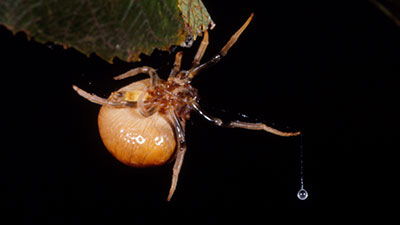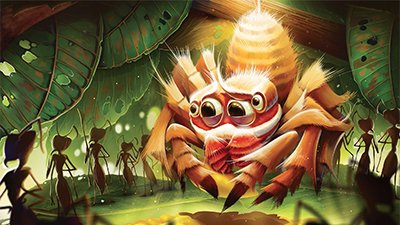Veggie-loving Spider
Most would agree that spiders are one of the more menacing predators in nature—spinning webs and lying in wait for helplessly trapped victims. But one Meso-American spider will have (almost) nothing of it.
News Source
- BBC News: “‘Veggie’ Spider Shuns Meat Diet”
Writing in Current Biology, a team of scientists reports on the first known spider that “feeds primarily and deliberately on plants” (“Herbivory in a Spider through Exploitation of an Ant–Plant Mutualism”). Called Bagheera kiplingi, the spider is unlike its 40,000 species of arachnid brethren that are entirely or almost entirely carnivorous.
A team of scientists reports on the first known spider that “feeds primarily and deliberately on plants.”
Instead, tiny B. kiplingi enjoys meals made up of the protein-filled tips of acacia plant leaves, called Beltian bodies. However, the spider must avoid pugnacious ants that live on the acacia plants and serve as de facto “bodyguards” for the trees, protecting the plant so that only they can eat the Beltian bodies.
“The spiders basically dodge the ants,” explained study coauthor Robert Curry of Villanova University. He continued,
The spiders live on the plants, but way out on the tips of the old leaves, where the ants don’t spend a lot of time, because there isn’t any food on those leaves. And they wait for an opening—they watch the ants move around, and they watch to see that there are not any ants in the local area that they are going after. And then they zip in and grab one of these Beltian bodies and then clip it off, hold it in their mouths and run away. And then they retreat to one of the undefended parts of the plant to eat it.
Interestingly, National Geographic News reports that Bagheera kiplingi was first described and named in the late nineteenth century. The describing scientists had only a dead specimen, however, and thus did not know what it ate.
Among the reasons Curry lists for the spider’s mostly plant diet are the tough competition for insect food in the tropics and B. kiplingi’s inability to weave webs. (B. kiplingi does occasionally eat ant larvae, so it would be wrong to label it entirely vegetarian.)
Many readers may have already guessed the thrust of our commentary to be how another “usual” carnivore is shown to have, at least in certain circumstances or species, an herbivorous diet. This, in turn, implies that some carnivores either are or were able to survive on herbivorous diets, but that anything from genetic to ecological changes leads them to eat other organisms (some or all of the time) instead. That reminds us of the reality of Genesis, which makes it clear that God created a world without death; death only entered through sin (Romans 5:12, as was warned in Genesis 2:17), and animals were originally vegetarian (Genesis 1:30).
We can conclude that they are not “alive” in the full.
But we must be cautious in saying that insects (most arachnids’ primary diet) are alive in the same sense that humans and most other animals are; Scripture uses nephesh chayyah to refer to “the living soul” or “the breath of life” in many creatures, and applies that term (in the Creation Week account) to sea creatures (Genesis 1:20–21), land animals (Genesis 1:24), birds (Genesis 1:30), and man (Genesis 2:7). The term is noticeably absent in the description of plants, so we can conclude that they are not “alive” in the full, Scriptural sense. But what about insects? Are they included in the “creeping things . . . in which there is life” that God created on Day 6 (Genesis 1:24–25, 30)?
While creationists continue to discuss and debate this topic, this news reminds us that many organisms that we assume must always be (and must always have been) carnivorous could once have been plant-eating only. In fact, even many creatures thought of as predatory (such as bears) subsist partially or mostly on plants. Several creatures use their menacing teeth to attack plant material (e.g., fruit bats), and paleontologists believe the sharp claws of velociraptors may have been used to scale tree trunks (see the September 19 News to Note).
Thus, conceiving of a world without carnivory isn’t such a stretch of the imagination, and each discovery of unexpectedly plant-eating animals reminds us of the historical reality of that pre-Curse world.
Further Reading
- ‘Life’ According to the Bible, and the Scientific Evidence
- Unexpectedly Vegetarian Animals—What Does it Mean?
- How Did Defense/Attack Structures Come About?
- Suffering
- Design in Nature
- Genesis
For More Information: Get Answers
Remember, if you see a news story that might merit some attention, let us know about it! (Note: if the story originates from the Associated Press, FOX News, MSNBC, the New York Times, or another major national media outlet, we will most likely have already heard about it.) And thanks to all of our readers who have submitted great news tips to us. If you didn’t catch all the latest News to Know, why not take a look to see what you’ve missed?
(Please note that links will take you directly to the source. Answers in Genesis is not responsible for content on the websites to which we refer. For more information, please see our Privacy Policy.)
Recommended Resources

Answers in Genesis is an apologetics ministry, dedicated to helping Christians defend their faith and proclaim the good news of Jesus Christ.
- Customer Service 800.778.3390
- © 2024 Answers in Genesis






